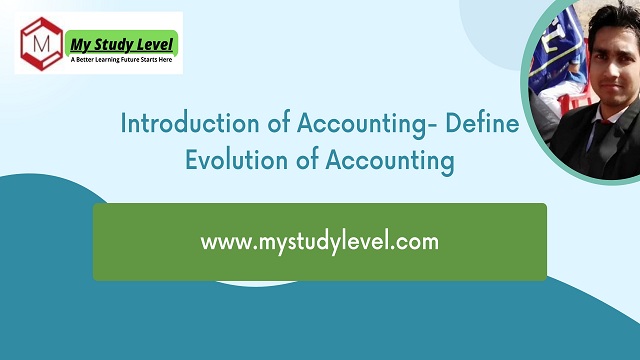Introduction of Accounting
The development of trade, industry and commerce world over has necessitated the recording of all business transactions, clearly and systematically. During the past few decades, business to highly mechanized ones. The tremendous growth of business has increased the volume of business has increased the volume of business transactions manifold.
The necessity of recording all the transactions clearly and systematically cannot be over-emphasized. Goods may be sold on credit to several persons. The buyer would pay the price of the goods to the vendor later. The vendor would like to know, from time to time that what amount is due and from whom. However strong one’s memory may be, one cannot hope to remember all the details regarding all the transactions. Apart from this, the object of business is to earn profits; and every merchant likes to know at the end of a financial year that how much profit he earned during the course of the year. For this purpose, he would need a lot of factual information which can be derived from written records of transitions, provided such records have been properly kept. As such, proper maintenance of books of accounts is indispensable for a businessman. Moreover, accounting written records are also essential for the following type of information required:
How much is the total revenue during the period?
What is the expenditure during the period on salaries, wages, lighting, insurance, rent, taxes etc.?
How much is the profit or loss?
How much is the capital and causes of its increase or decrease?
Nature and value of assets possessed by the business.
Nature and amount of liabilities
Customers who over to the business possessed by the business.
Suppliers to whom the business has to make payments and the amount in each other and
Others facts for filling value added tax or income tax returns.
Limited companies, charitable organizations and now, limited liability partnerships compelled by law to maintain proper records of their financial transactions. Although traders and partnerships firms are not subject to legal obligation, it is very much in their internet to keep proper financial records for the survival as well as growth of the business.
Evaluation of Accounting
The history of accounting dates back to the earliest days of human agriculture and civilization when the need to maintain accurate records of the quantities and relative value agricultural products first arose. Simple accounting is mentioned in the Christen Bible in the book of mathhew in the parable of the Talents (Math. 25: 19). The quran also mentions simple accounting for trade and credit arrangements *(Quran 2 : 282). Kautilya’s famous Arthasha not only relates to politics and economics, but also explains the art of account keeping. Written in 4th century B.C. in Shlokas or Sanskrit verses, a chapter in the book provided the details of account keeping, accountant’s office, methods of supervising and checking of accounts and about the distinction between capital and revenue, profits, expenses, etc.
The development in trade and commerce has been responsible for the growing importance a methodical accounting work. It is in the important world trade centers of Geneva and Venice, the Italian cities that a systematic method of accounting developed between 14th and 15th centuries.
Luca Pacioli (1445-1517) also known as Friar Luca dal Borgo wrote a book, primarily on mathematics, “Summa de Arithmetica, Geometrica, Proportioni et Proportionalita” (Review of Arithmetics, Geometry and Proportions) in 1494. This book contains a brief section under the chapter heading “Particularis de computis et scripturis” (Particulars of Reckoning and their recording) on double entry system of book-keeping. Although Pacioli codified rather than invented this system, he is widely regarded as the father of modern accounting.
Pacioli was a great philospher of Italy. His book is the first printed book on double entry system. The review of literature suggests that Benedetto Cortugli completed a book on double entry system in 1458 but it was not published till 1573.
Pacioli used the term ‘debito’ (owed to) and ‘credito’ (owed by); these came from the latin words debitur and creder. The terms used today have their origin from debitur and creder. The system he published included most of the accounting cycle as we know it today. He described the use of journals and ledgers, and warned that a person should not go to sleep at night until the debits equaled the credits! He was in favor of closing accounts every year. He stressed on the measurement of profit or loss at regular interval. He also suggested the preparation of a Inventory’ i.e., financial position of a business which is called ‘Balance Sheet’ now.
However, Pacioli’s book initiated an important step in keeping of records under double-entry system. In the succeeding years, many improvements took place in the accounting books and methods for the convenience of different organizations. Industrial revolution of 18th century and Gartner ships globalized trade necessitated further improvements in accounting, such as mechanized accounts, although computerized accounting statements, etc.













Leave a Reply